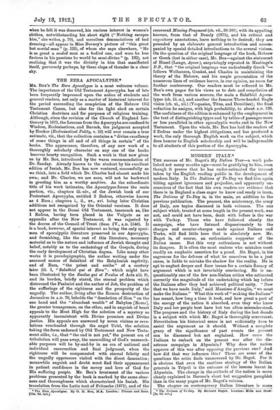THE EZRA APOCALYPSE.*
MR. Box's The Ezra Apocalypse is a most welcome volume. The importance of the Old Testament Apocrypha has of late been frequently impressed upon the notice of students and general readers, not only as a matter of historical interest for the period succeeding the completion of the Hebrew Old Testament Canon, but also for the light shed on certain Christian doctrines and for purposes of religions training. Although, since the revision of the Church of England Lec- tionary in 1871, the Lessons from the Apocrypha are confined to Wisdom, Ecclesiasticus, and Baruch, the judgment accepted by Hooker (Ecclesiastical Polity, v. 20) will ever remain a true estimate, viz., that the collection contains a "divine excellency of some things in all and of all things in certain" of the books. The appearance, therefore, of any new work of a thoroughly scholarly character on any one of the books leserves hearty recognition. Such a work is that now given us by Mr. Box, introduced by the warm recommendation of Dr. Sanday. Already known to the student by his excellent edition of Isaiah, Mr. Box has now ventured, successfully as we think, into a field which Dr. Charles had almost made his own; and Dr. Charles, we are sure, will not be backward in greeting him as a worthy confrere. As the subordinate title of his work intimates, the Apocalypse forms the main portion, viz., chapters iii.-xiv., of the Jewish book of our Protestant Apocrypha, entitled 2 Esdras, otherwise known as 4 Ezra ; chapters i., ii., ay., xvi. being later Christian additions not recognized by the Oriental versions. It does not appear in the Douai Old Testament, inasmuch as, like 1 Esdras, having been placed in the Vulgate as an appendix after the New Testament, it was rejected by the decree of the Council of Trent (Sess. IV., A.D. 1546). It is a book, however, of special interest as being the only speci- men of apocalyptic literature preserved in our Apocrypha, and furnishing, like the rest of this literature, necessary material as to the nature and influence of Jewish thought and belief, notably as to the eschatology of the Gospels, during the early development of Christian dogma. Like many other works it is pseudepigraphic, the author writing under the assumed names of Salathiel of the Babylonish captivity, and of Ezra, "the priest and scribe" of a century
later 1, " Salathiel qui et Ezra": which might have been illustrated by the Saulus qui et Paulus of Acts xiii. 9), and its burden, briefly stated, the eternal problem which distressed the Psalmist and the author of Job, the problem of the sufferings of the righteous and the prosperity of the ungodly. The author, living after the Roman destruction of Jerusalem in A.D. 70, beholds the "desolation of Sion " on the one hand and the "abundant wealth" of Babylon [Rome], the greater transgressor, on the other, and in anguish of heart appeals to the Most High for the solution of a mystery so apparently inconsistent with Divine promises and Divine justice. His appeals are answered by seven visions or reve- lations vouchsafed through the angel ljriel, the solution taking the form endorsed by Old Testament and New Testa- ment alike, i.e., that "the end is not yet," the present era of tribulation will pass away, the unravelling of God's unsearch- able purposes will be by-and-by in an era of national and individual resurrection and final judgment, when the righteous will be compensated with eternal felicity and the ungodly oppressors visited with the direst damnation ; meanwhile anguish and doubt must find their appeasement in patient confidence in the mercy and love of God for His suffering people. Mr. Box's treatment of the various problems presented by the book is marked by the same clear- ness and thoroughness which characterized his Isaiah. His translation from the Latin text of Fritzsche (1871), and of the
• The Ezra Apocalypse. By G. H. Box, M.A. London : Pitman and Sons. [10s. 6d. net.]
recovered Missing Fragment (ell. vii., 36-105), with its appalling horrors, from that of Bensly (1875), and his critical and expository annotations, leave nothing to be desired; they are preceded by an elaborate general introduction and accom- panied by special detailed introductions to the several visions. On the question of the original language of the book, Hebrew or Greek (lost in either case), Mr. Box—against the statement of Bissel (Lange, Apocr.), surprisingly repeated in Hastings's D.B., that " the original language was undoubtedly Greek "--• follows Welhausen, Gunkel, and Charles in maintaining the theory of the Hebrew, and his ample presentation of the numerous lines of evidence leaves, in our opinion, no room for further controversy. Our readers must be referred to Mr. Box's own pages for his views as to date and compilation of the work from various sources, the main a Salathiel Apoca- lypse (ch. iii.-x.), and another the famous Three-headed Eagle vision (ch. xi., xii.) (Vespasian, Titus, and Domitian) ; the final redaction he assigns, with high probability, to about A.D. 120. The usefulness of the edition is enhanced by the employment in the text of distinguishing types and by tables of passages more or less paralleled in other apocalyptic works and in the New Testament. Upon the whole, Mr. Box has laid the readers of 2 Esdras under the highest obligations, and has produced a work, the only thorough English work on the subject, which does honour to English scholarship and will be indispensable to all students of this portion of the Apocrypha.






































 Previous page
Previous page